Thesis
A significant portion of the workday for professional, white-collar workers is wasted on rote tasks. On average, these workers, who made up 57.8% of the U.S. workforce as of 2024, spent 28%, or roughly 2.6 hours, of their workday reading and answering emails as of 2019. Other estimates suggested that the average professional worker sent 200 Slack messages a week as of 2019. These workers also spent 30% of their workday working on spreadsheets and half an hour trying to figure out their IT system as of 2020. These tasks are often routine and time-consuming, detracting from higher-value, creative, or strategic work.
Productivity solutions can be complicated to set up, requiring technical knowledge and, therefore, significant company investment. For instance, one of the most popular productivity solutions, robotic process automation (RPA), must often be set up and maintained by specialized RPA developers with technical knowledge. As of 2022, according to Magical co-founder Rosie Chopra, implementation can take months, making it inaccessible to many organizations without dedicated technical teams.
In contrast, no-code tools and agentic AI solutions appear to be gaining traction as a more accessible alternative. With intuitive, user-friendly interfaces, no-code tools allow non-technical users to build software solutions and internal tools independently, reducing reliance on engineering resources. For example, website builders like Squarespace and WordPress, each valued at approximately $7 billion as of late 2024, enable users to launch professional websites using templates and drag-and-drop tools. Airtable, valued at $11.7 billion in 2023, has been adopted by over 500K organizations, including AWS, Walmart, and BlackRock, to build custom business applications without writing code. Shopify, with a market cap exceeding $80 billion as of mid-2024, enables merchants to create and manage e-commerce storefronts without a technical background. Other companies like Stripe are also expanding into no-code solutions.
As of November 2024, agentic AI has been gaining traction as the “third wave” of artificial intelligence, focused not on prediction or content generation, but on autonomous action. Unlike traditional RPA, which follows fixed rules, agentic AI can make decisions, adapt to changing inputs, and execute multi-step tasks with minimal human input. As of May 2025, companies like Google, Microsoft, and Salesforce are actively incorporating agentic capabilities into tools for customer support, workflow automation, and internal operations, indicating growing enterprise demand for AI that can act independently.
Founded in 2020, Magical aims to disrupt traditional RPA by using both no-code design and agentic AI. The platform allows users to create productivity shortcuts such as text expansion templates, auto-fill workflows, and AI-generated content in minutes, with no technical expertise or engineering resources needed. These automations can be deployed at the individual or team level and reportedly save users an average of seven hours of work per week.
Founding Story
Magical was founded in 2020 by husband-and-wife team Harpaul Sambhi (CEO) and Rosie Chopra (COO), alongside co-founders Zach Piepmeyer (Head of Design) and Prashant Viswanathan (Head of Growth). The idea for Magical emerged during the COVID-19 lockdown, as Sambhi and Chopra began exploring ways to automate repetitive, manual tasks — an effort rooted in their shared goal of building tools that meaningfully improve people’s day-to-day work.
Sambhi is a serial entrepreneur whose first company, Careerify, offered referral automation and employer branding tools. Sambhi described himself as a serial entrepreneur whose interest in business was sparked from an early age. As a kid, he would resell cereal as “Harpaul Loops” to neighbors. He bootstrapped Careerify while studying at the University of Waterloo and scaled it to profitability within two years. The company was acquired by LinkedIn in 2015, serving over 250K users and enterprise clients including Microsoft, Deloitte, Unilever, and SpaceX. Following the acquisition, Sambhi held product leadership roles at LinkedIn and Microsoft, focusing on human capital management and HR technology. He later served as an entrepreneur-in-residence at Bain Capital Ventures and became a limited partner in several venture funds.
Chopra brings a background in finance, strategy, and product leadership. She holds bachelor’s and master’s degrees in accounting and finance and has worked in financial analysis at KPMG, strategy consulting at GE, and management consulting at Deloitte. Most notably, she led strategy and business operations at Atlassian before joining Inovia Capital as an executive-in-residence. During Sambhi’s Careerify years, Chopra provided informal advisory support before joining him formally as a co-founder of Magical.
The pair recruited two former collaborators of Sambhi as co-founders. Piepmeyer was a principal UX designer at LinkedIn, while Viswanathan had been one of four early employees at Careerify and later served as VP of Engineering at Swift Medical.
As of May 2025, Magical has grown to a team of over 20 employees and nearly one million users. The leadership team has expanded to include Raffaello d’Amore (Head of Product), who joined in 2021 and was promoted through multiple product leadership roles, and Jared Wein (Head of Engineering), who joined in January 2023 from Mozilla, where he was a senior staff software engineer and engineering manager.
Product
In May 2025, Magical launched a suite of enterprise AI tools for complex, large-scale automation. It also continues to offer its original freemium browser extension, which includes a text expander, autofill features, and a ChatGPT-based generative AI writing tool.
Agentic AI
Magical’s Agentic AI claims to automate complex workflows with no human input required. Unlike traditional automation tools that rely on rigid, rule-based steps, Agentic AI uses large language models (LLMs) and reasoning systems to navigate dynamic environments and make decisions based on context.
These AI agents run on virtual machines, allowing them to perform large-scale operations, including moving data between systems, submitting forms, extracting information from documents, and formatting inputs without manual assistance. A practical example of Magical’s agentic AI workflow includes extracting data from PDFs and populating it into online forms.
This tool is suitable for automating unstructured, multi-step tasks such as prior authorizations and claims management in healthcare or complex business processes, particularly in domains like revenue cycle management (RCM), where workflows are non-linear, data is unstructured, and multiple systems must be integrated.
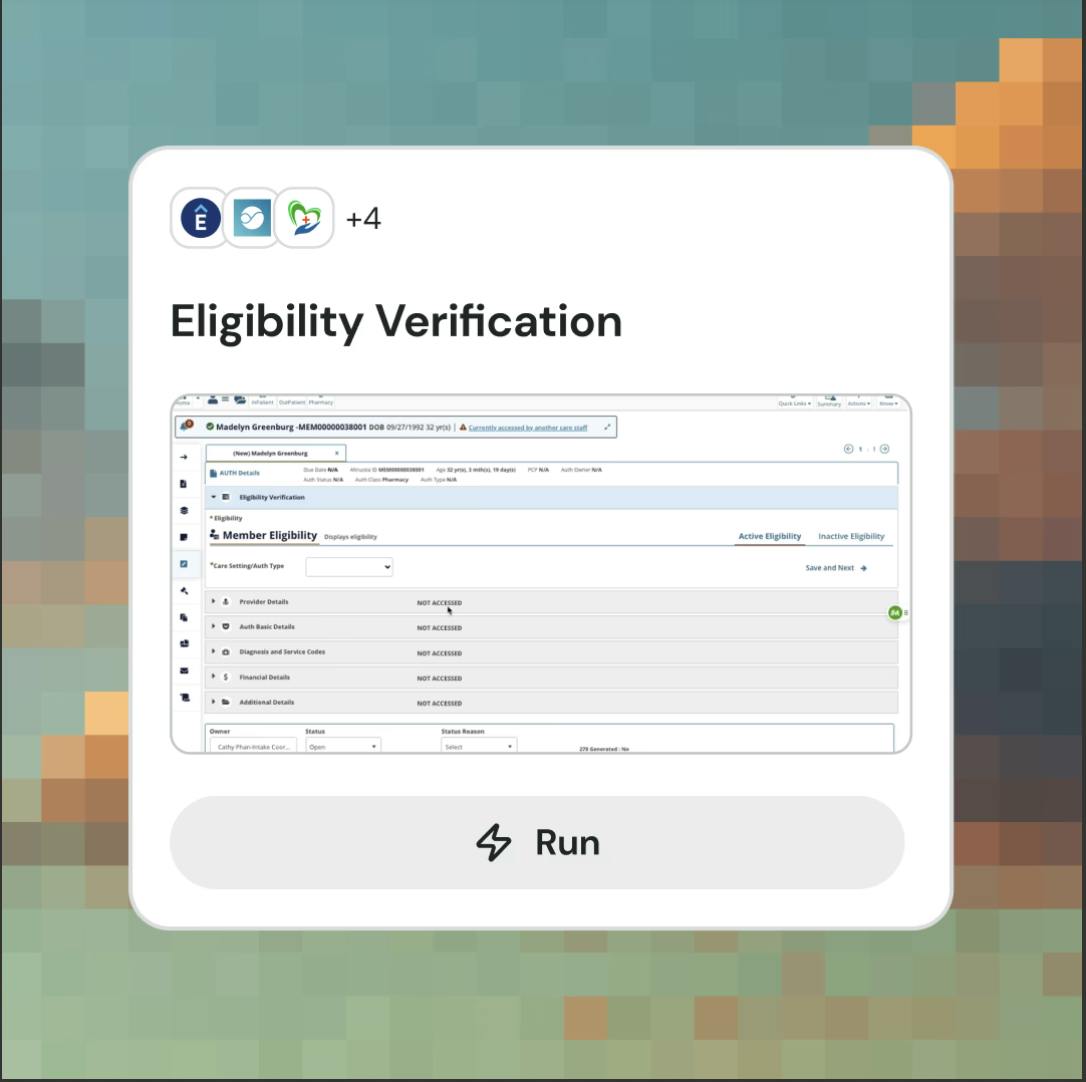
Source: Magical
The key distinction from conventional automation is that Agentic AI uses contextual understanding and goal-driven execution to complete tasks. It can interpret information, adjust behavior based on outcomes, and continuously improve over time.
Process Mining
Process mining captures and analyzes real-time user interactions and system events to reconstruct how workflows are performed across an organization. Mapping these processes identifies inefficiencies, deviations, and areas for improvement.
Magical’s process mining tool passively collects data from everyday activities without requiring manual input. The system then visualizes current processes and highlights bottlenecks or redundant steps. Insights from process mining can also be used to train AI agents. By learning from observed workflows, agents can be developed to replicate routine tasks and automate them at scale. This approach can enhance operational efficiency while reducing reliance on manual intervention.
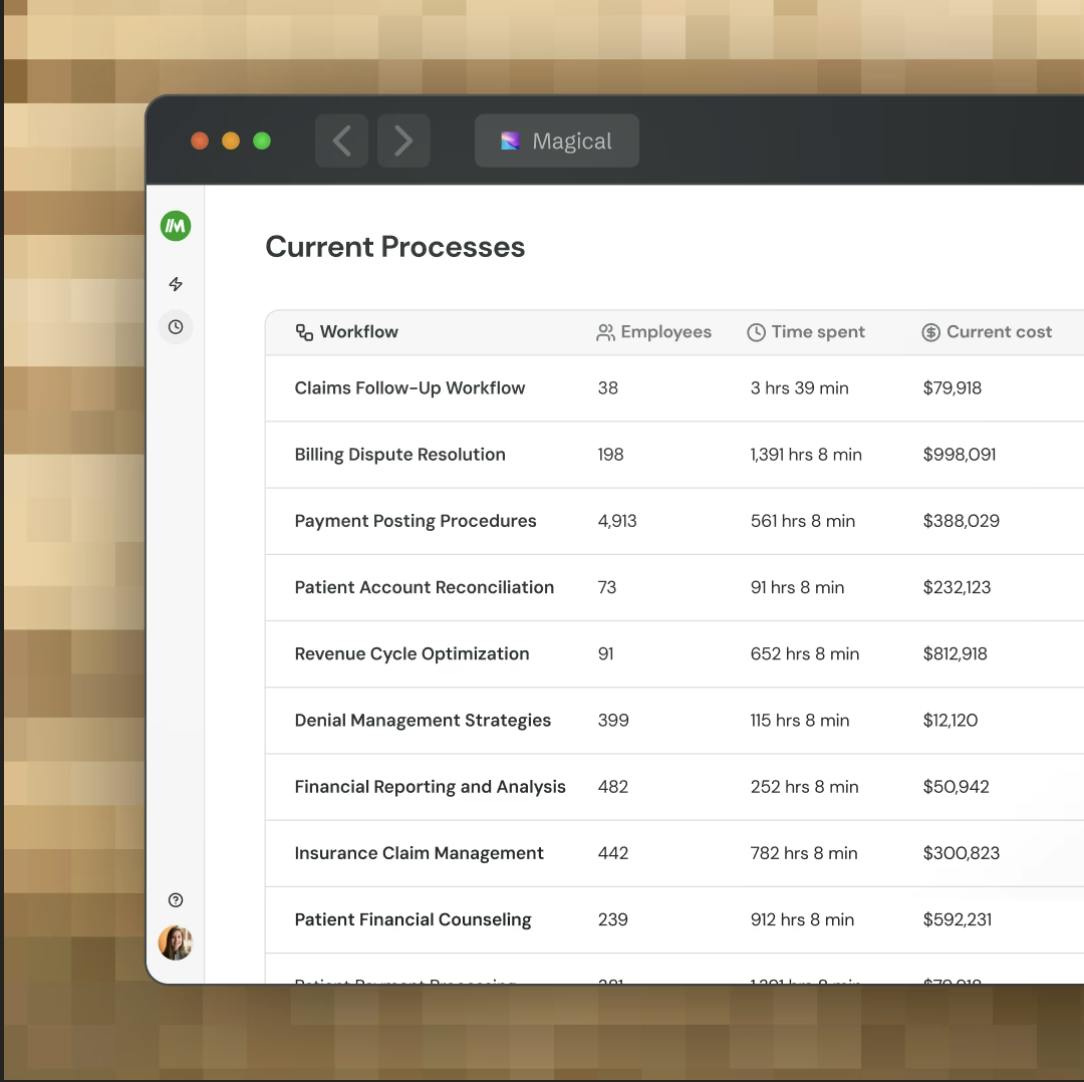
Source: Magical
Human-Assisted Automations
Human-assisted automations allow users to automate multi-step workflows across systems while maintaining oversight and control. These automations can be triggered with one click and can reduce the time required to complete routine processes.
Users can create automations through three methods: by recording a task, using a step-by-step visual builder, or describing the workflow in natural language. Once created, automations can be reused indefinitely. Users can monitor automations in real time and intervene as needed. Magical claims to reduce workflow time from minutes to seconds while maintaining oversight for critical processes.
The system captures data during automation use, allowing the AI to continuously improve and adapt over time. This also acts as a foundation for transitioning to fully autonomous agentic AI, once the automation has been sufficiently refined through human-assisted execution.
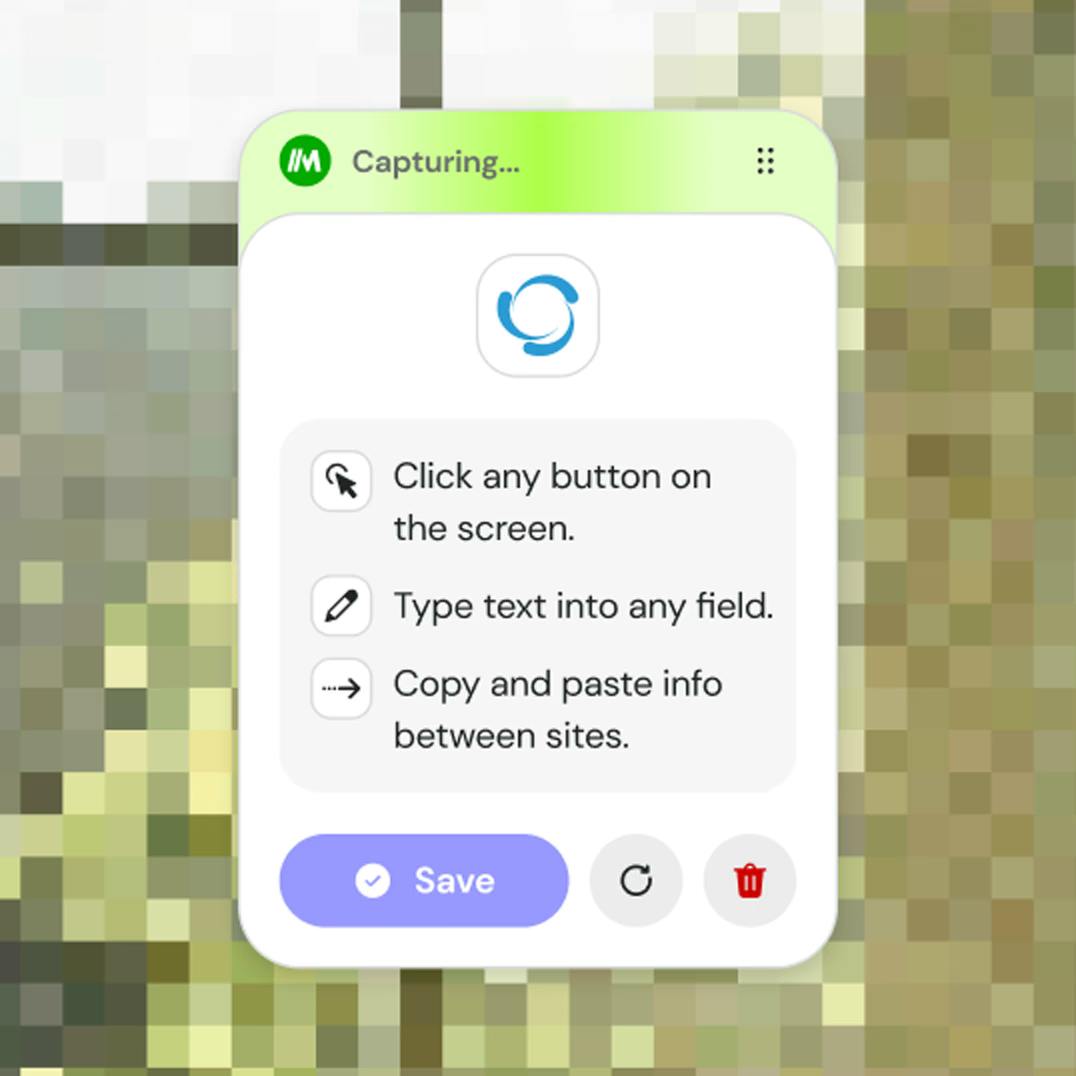
Source: Magical
Integrations
Magical’s no-code platform enables teams to move data between any app, including internal tools, legacy systems, and back-end platforms, without the need for costly integrations or APIs. As of May 2025, Magical supported connections with millions of applications, including Google Sheets, Salesforce, HubSpot, LinkedIn, Greenhouse, and Zendesk.
Its solutions are adaptable across industries and functions, including healthcare, sales, support, and HR. In healthcare, for example, Magical can automate data entry into EHR systems and insurance portals, addressing the lack of interoperability common to these platforms. Automating this work also helps reduce the risk of human error from manual data entry.
Other Features
In addition to its suite of AI automation products, Magical offers free features that are included in a limited capacity within its free Chrome and Edge browser extension.
Text expander: Magical’s first feature was its text expander, in which users can save common texts like email boilerplates or customer support macros as templates and access those templates with custom abbreviations. Templates can be personalized with the specific details of each use and shared between teammates. Users can create their own templates through a simple copy-and-paste mechanism or access pre-built templates from Magical’s library.
Auto Form Filler: Magical’s browser extension can automatically fill online forms without requiring any technical implementations. Once installed, it can pull relevant data from open sources like customer profiles, emails, or databases and automatically populate form fields with a single click. Unlike typical autofill tools that store personal information, Magical pulls data directly from the source without storing it. Powered by AI, it can recognize and fill specific form fields like customer names, invoice numbers, or ticket numbers, streamlining repetitive tasks and saving time for users.
Magical AI: Magical launched Magical AI to enable users to generate written content using AI. Powered by ChatGPT, the tool learns from individual and team templates to ensure a consistent tone and voice. It leverages generative AI to respond to user prompts directly within their workflows.
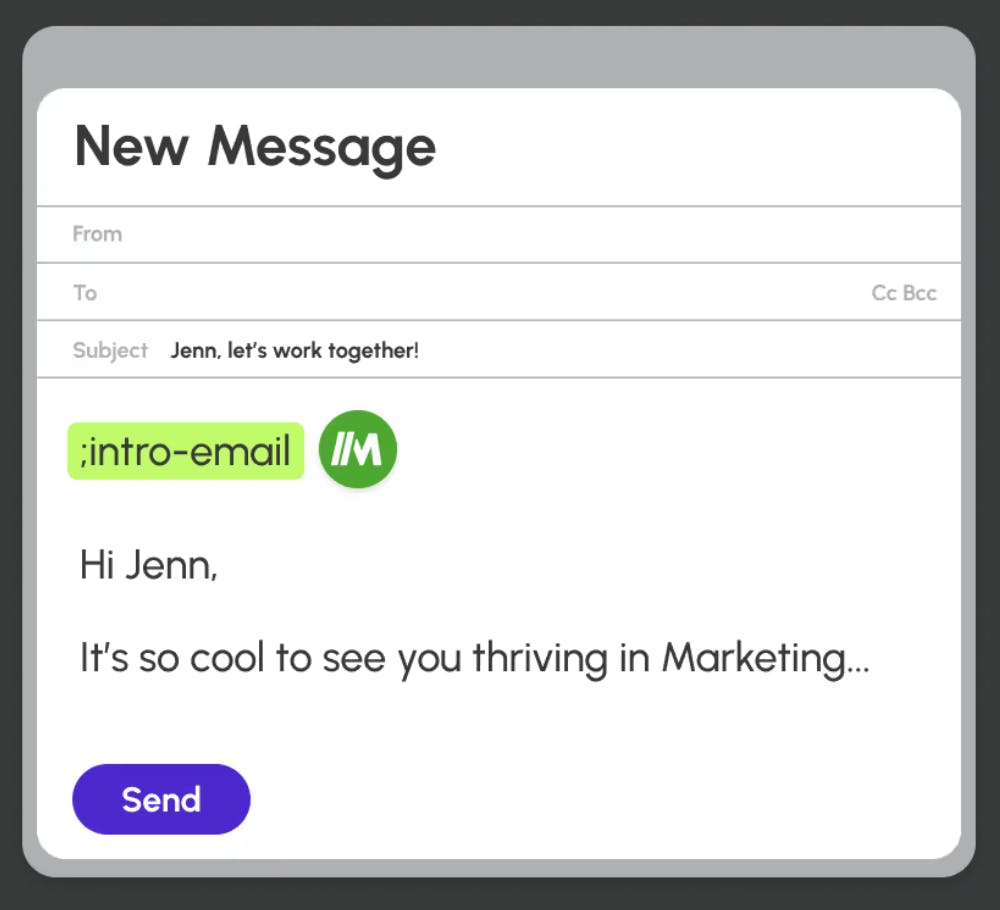
Source: Magical
Market
Customer
Magical serves enterprise customers looking to automate time-consuming tasks and workflows. The platform enables companies to begin automating within days using one-click automations and also identifies additional automation opportunities. While not limited to specific industries, Magical highlights use cases in healthcare, customer support, finance, and insurance. As of May 2025, Magical had 950K users across 100K companies, including Amazon, Airbnb, Netflix, Atlassian, HubSpot, and Intuit.

Source: Magical
Customer use cases
Deel: A global HR platform used Magical to save 10–15 hours per week per team member by automating over 380 repetitive tasks monthly. The sales team used Magical’s text expansion and autofill features to streamline customer communication, reducing time spent searching for templates and manually responding to common questions. Over 100 employees adopted the tool to improve efficiency and increase lead conversion.
Zoomcare: A digital-first healthcare provider operating over 50 clinics uses Magical to streamline patient documentation and follow-up communication. Over 200 providers use text expansion and template features to complete patient charting and care instructions more efficiently, saving an average of four hours per week per provider. This has led to reduced administrative workload, more timely appointments, and improved patient experience without requiring IT support or compromising data security.
Freshworks: A SaaS company’s sales team uses Magical to automate CRM updates and repetitive messaging, saving over 30 minutes per day per user. Features like text expansion, shortcuts, and variable-based personalization help reduce manual work and increase consistency. The tool also supports remote collaboration by allowing team members to share templates and workflows efficiently.
Market Size
Magical is expanding beyond traditional RPA into the emerging agentic AI and enterprise productivity markets. While the RPA market was valued at $13.9 billion in 2023 and was projected to reach $64.5 billion by 2032, its growth was hindered by complex setup processes and slow adoption. Industry analysts have noted signs of consolidation, with valuations of major RPA firms falling and smaller players being acquired. Magical aims to differentiate itself by offering simpler, faster automation deployment and more adaptive technology.
In 2025, the company entered the agentic AI market, which was valued at $5.2 billion in 2024 and is projected to reach $196.6 billion by 2034, growing at a 43.8% CAGR, driven by demand for greater productivity, reduced human error, and more autonomous decision-making. Growth is also supported by advances in natural language processing, machine learning, and AI reasoning systems, which enable automation to handle more complex and variable workflows. By 2028, 33% of enterprise software applications are expected to include agentic AI capabilities as of March 2025.
Magical also competes in the broader enterprise productivity market, valued at $60 billion in 2023 and projected to grow at 14.1% annually through 2030, driven by the need to reduce manual work and improve operational efficiency.
Competition
Competitive Landscape
Magical positions itself as an RPA alternative in a competitive market with long-established incumbents. While RPA became a defined category in the 2000s, its roots trace back to automation efforts in the 1990s. The rise of no-code platforms and generative AI has introduced new competitors and forced incumbents like UiPath and Automation Anywhere to evolve in agentic AI-driven companies. Magical competes with both legacy RPA vendors and newer companies using emerging technologies to target business productivity.
Legacy RPA Companies
UiPath: Founded in 2005, UiPath is a public company with 4K employees and $1.4 billion in revenue reported for the 2024 fiscal year. UiPath originally launched as an RPA platform to help businesses build "high-performing robots" and manage automated workflows. By 2023, the company introduced AI-powered features such as Autopilot, document understanding, analytics querying, code automation, and process mining, and rebranded as an “AI business automation platform” as of December 2024. As of May 2025, UiPath has rebranded again — this time as an enterprise-grade agentic automation platform.
While Magical emphasizes a no-code experience, UiPath is primarily a low-code solution. Its platform includes two main offerings: Studio, designed for professional RPA developers, and StudioX, which targets business users without coding experience. While it may be more challenging to build automations, especially complex ones, on UiPath, the company benefits from a large user base that provides community support in the form of online forums, tutorials, and events.
Beyond agentic automation, UiPath also offers agentic testing, unlike Magical, enabling it to serve technology and SaaS enterprise clients for testing needs. UIPath is reported to have built out its agentic AI toolset by October 2024, whereas Magical didn’t release its comprehensive agentic AI product offering until around May 2025.
Automation Anywhere: Founded in 2003, Automation Anywhere began with the goal of automating repetitive business tasks. While the company is privately held and does not disclose revenue figures as of May 2025, it has raised over $1.1 billion in funding as of May 2025, acquired over 5K clients, and collaborated with Google and IBM as of November 2024.
In 2024, the company launched its AI Agent Studio, a low-code platform that enables users to build custom AI agents capable of executing tasks across various enterprise systems. The platform supports multiple AI models, including those from AWS, Google Cloud, and Microsoft’s Azure OpenAI service. One of Automation Anywhere’s standout capabilities is its use of generative AI to process unstructured data, such as handwritten documents, with up to 90% accuracy. As a mature RPA player with a large customer base, Automation Anywhere also offers robust community support, including developer forums, training and tutorials, and events, much like UiPath.
No-code Startups
Zapier: Y Combinator-backed startup Zapier was founded in 2011 and, as of 2023, was valued at $5 billion. The majority of the value appears to come from its own profits, as the company has only raised $1.4 million as of May 2025. Zapier offers no-code workflow automation used by over 2.2 million businesses, enabling users to create workflows using natural language with the help of its AI-powered Copilot.
While the platform is designed for accessibility, its original developer interface still presents a learning curve. Users often need to consult documentation and tutorials to get started. Like more established RPA companies, Zapier has built a strong community, featuring an active forum and in-person meet-ups for user support and engagement.
In January 2025, Zapier launched Zapier Agents, a feature that allows users to create custom AI agents in minutes using plain English. Similar in function to Magical’s agentic capabilities, Zapier’s earlier launch gives it a potential first-mover advantage.
Glean: Founded in 2019 by former Google engineers, Glean is a Series D startup that enables companies to build AI assistants to streamline employee workflows. In September 2024, Glean raised a Series E round of $260 million, bringing its total funding to $618.2 million as of May 2025 and valuing the company at $4.6 billion as of December 2024.
Glean’s platform offers two core AI-powered capabilities: querying an organization’s internal knowledge graph through an AI chat assistant and building automations for workplace tasks using a low-code/no-code interface. With Glean, users can create “Glean Apps” using plain language instead of code, allowing employees to automate tasks across their connected applications quickly and intuitively. To foster user success, Glean also supports a growing community of “Gleaners”, where users can collaborate, share tips, and help each other navigate the platform.
Invisible Technologies: Invisible Technologies, founded in 2015, provides an AI Process Platform that combines automation tools with human process experts to help enterprises automate and manage complex workflows. As of May 2024, the company supported over 300 integrations and uses limited-access large language models to enable automation across functions such as data cleaning, order fulfillment, supply chain management, and compliance. As of May 2025, Invisible worked with companies including AWS, Nasdaq, Cohere, and American Family Insurance.
Unlike Magical, which relies on users to build their own automations, Invisible assigns process experts to help map, maintain, and adapt workflows. The company reported $134 million in revenue in 2024 and, as of February 2025, has raised $23 million in funding from investors such as Day One, Greycroft, and Backed.
Business Model
As of May 2025, GetMagical appears to be shifting toward an enterprise-focused business model. Magical’s core features, text expanders, and autofill, remain free via its Chrome and Edge extensions. The company appears to be monetizing its more advanced AI-powered, agentic products through enterprise sales. Demos are used to showcase these capabilities with tailored examples relevant to the customer’s workflow. During these demos, enterprise customers can discuss their specific use cases and pain points. Pricing and packaging are explored during these calls or later calls.
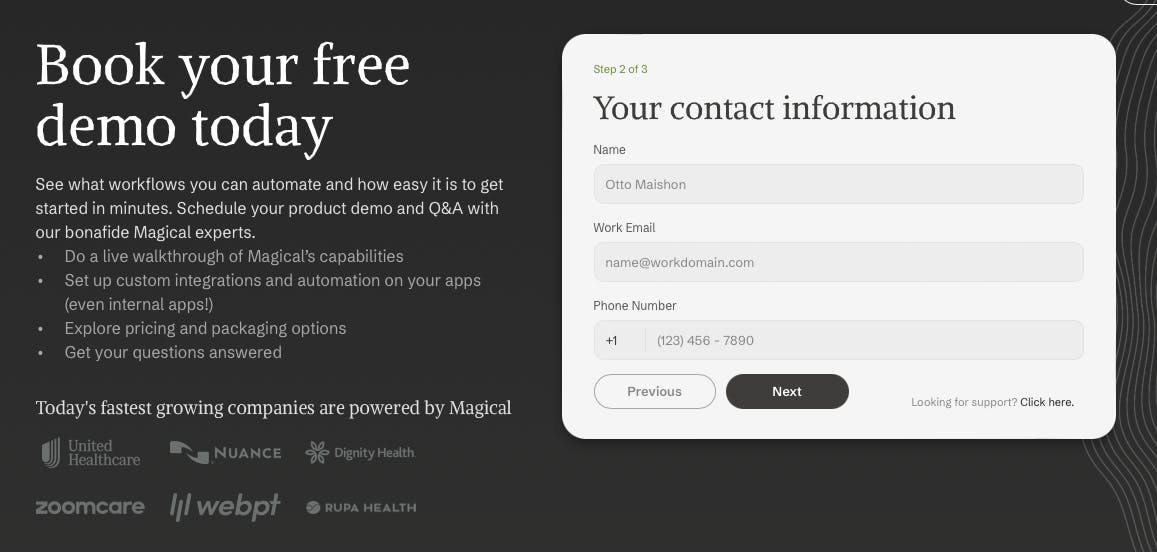
Source: Magical
Previously, as of December 2024, Magical operated on a freemium pricing plan, where users could try out limited features and rates each month without paying for the tool. The free plan offered 600 monthly text expansions, 100 monthly workspace automations, community support, and unlimited template storage. The Core plan, which cost $6.50 per user per month, added unlimited text expansions for a single user and email support, and the Team plan, which was $12 per user per month, included unlimited text expansions for all users, as well as team administrative and management features. However, all three plans only included 100 monthly automations.
The Enterprise plan, designed for teams with 10 or more users who require more automations, offered custom usage limits, multi-step automations, custom onboarding, dedicated support, and enterprise governance tools. All users, regardless of their plan, were also able to access Magical’s free AI writing tool.
Traction
Magical began as a productivity tool aimed at helping employees streamline repetitive communication. Its initial version functioned as a messaging tool that enabled users to quickly access frequently used text and common phrases.
By June 2022, Magical had evolved into a no-code, AI-enhanced alternative to traditional robotic process automation (RPA). It launched a text expansion tool that allowed users to automate data transfers across web applications using keyword prompts. That same year, the product launched on Product Hunt and became the #1 Product of the Week. In June 2022, Magical had grown to over 450K users and was adopted by more than 10K businesses, including teams at Disney, Facebook, Salesforce, and Uber. Much of its early momentum came from its free-to-use model.
Following the release of ChatGPT in November 2022, Magical began integrating AI capabilities more deeply. In September 2023, it introduced its AI Reply feature, which enabled automated email and message responses.
By 2024, Magical had repositioned itself as an AI agent focused on automating manual workflows across systems, without the need for specialized development or complex setup. It was marketed as an "ambient automation app," available as a browser extension for Chrome and Edge. Unlike traditional RPA tools, Magical required no integrations and could be set up by non-technical users in as little as 15 minutes. As of June 2024, the platform reported over 30K connected applications, surpassing Zapier, and had automated more than 3.7 billion tasks.
Product development appeared to slow in 2024. A key functionality already offered by some RPA competitors — generating automations from natural language — was still in development as of December 2024. However, around May 2025, Magical released a new, enterprise-focused product suite consisting of agentic AI, process mining, and human-assisted AI automation. Despite its evolution, as of May 2025, Magical has retained its original functionality, such as auto-filling text, while adding features like AI-powered email writing.
Valuation
In 2022, Magical raised a $35 million Series A round led by Coatue, bringing its total funding to $41 million as of May 2025. Its angel investors include founders of Loom, Intercom, and Lattice, along with executives from Figma and Atlassian. While the company has not publicly disclosed its valuation, estimates as of June 2022 ranged between $140 million and $210 million.
Key Opportunities
Platform and Integration Expansion
As of May 2025, Magical was a browser extension only available on Chrome and Edge, as well as some Chromium browsers. While Chrome and Edge browsers represented 66.2% and 5.2% of the market share, respectively, as of April 2025, other browsers, such as Safari and Firefox, may be preferred by users, especially specialized workers with unique priorities, for integration, performance, or privacy reasons.
Magical could not only be extended to other browsers but also released in a different format — a desktop app — to boost productivity. A major limitation of Magical is that it can only operate in a single browser, preventing it from accessing important desktop apps that other automation tools can access, such as Excel’s desktop app or iCloud Mail. On Magical’s community forum, users previously requested a desktop app format, which would allow them to build automations across browsers and desktop apps. This could also give Magical a competitive edge over AI services, such as ChatGPT or Claude, which can streamline workflows through text generation but cannot yet move data across browsers or apps as of May 2025.
Therefore, while expanding to more browsers and a different format could be a significant technical investment, such an expansion would not only increase the pool of potential customers but also improve Magical’s utility to existing customers as well.
Specialized Use Cases
As of May 2025, Magical advertises itself as a tool for four different roles on its website: healthcare, sales, customer support, and recruiting. However, developing Magical as a solution for even more specialized functions could help set Magical apart from its competitors, which are typically general-purpose. Additionally, since generative AI models are general in nature, they can already automate broad tasks, and therefore, a focus on specific tasks or functions could be a key differentiator for Magical.
For instance, Magical could build out different features and add popular integrations for these specialized functions. For instance, Magical could support designers by adding a Figma integration, as well as automations such as importing data from Airtable, applying set styles, creating placeholders, and extracting differences between two designs. With a Figma integration, Magical could also support software engineers by allowing automations that transfer data from Figma to Jira, streamlining the ticket shaping and sprint planning process. Magical could also focus on engineering-specific features, such as ticket templates and updating documentation.
Agentic AI capabilities could take this further by enabling autonomous agents to navigate complex tasks end-to-end, such as triaging incoming bug reports, generating draft tickets, assigning them based on workload data, and updating relevant documentation in real time. Process mining could also be applied to engineering or design teams to analyze and visualize how work is actually performed, identify inefficiencies in handoffs or redundant approvals, and automatically suggest areas for automation or process improvement. These use cases illustrate how Magical can go beyond surface-level automation and become an embedded, intelligent layer across specialized workflows.
Key Risks
Legal and Security Risks
Magical describes itself as an “ambient automation app” that operates in the background to identify repetitive behaviors and suggest automations in real time. By observing users’ keystrokes and workflows, it simplifies the process of building automations. However, this "always-on" presence raises potential concerns around data privacy and enterprise security.
To address these risks, as of May 2025, Magical stated that it does not collect or store user keystrokes and that all user data is encrypted. It has also achieved SOC 2 Type II compliance, indicating it passed a six-month or longer audit that assesses controls related to security, availability, processing integrity, confidentiality, and privacy. Magical is also HIPAA compliant, meaning it meets the standards set by the U.S. Health Insurance Portability and Accountability Act (HIPAA) for handling protected health information (PHI).
Like other RPA platforms, Magical faces common security risks, such as unintentional data exposure when automation bots send information to incorrect destinations, compromised credentials stored across services, and vulnerabilities introduced through third-party integrations. Additionally, while Magical’s AI is trained on users’ saved templates to improve personalization, this could present further risks if sensitive content is inadvertently included.
Legal risks may also emerge from Magical’s web scraping feature, which allows users to extract data from any website accessible via Chrome. Although this functionality is marketed as simple and accessible, the responsibility for ensuring scraping activities comply with a website’s terms of service falls entirely on the user. This becomes more legally complex as the use of generative AI has reignited debates around data ownership, privacy, and intellectual property.
Ultimately, while Magical has implemented key safeguards, unresolved security and legal concerns, particularly around data privacy, AI training, and scraping, could pose barriers to adoption among large enterprises and regulated industries.
Competitor Risks
AI Automation Tools: As legacy RPAs expand into agentic AI, it may become harder for Magical to differentiate itself. Despite its own advancements in agentic AI, Magical faces the challenge of competing with legacy players who have deeper resources and established enterprise relationships. Without clear differentiation in AI reliability, user trust, and seamless integration, Magical risks becoming overshadowed in an increasingly AI-driven market.
Text Expander Feature: Generative AI is enabling other platforms to automate workflows, putting Magical at risk of redundancy. For example, Google’s AI writing features could replace Magical’s AI email replies and text expansion. Google’s integration of Gemini into Gmail and Docs could render some of Magical’s email autofill and templates obsolete. Similarly, LinkedIn Recruiter is incorporating generative AI features like messaging and CRM integrations, which overlap with Magical’s use cases in talent acquisition. As AI streamlines workflows, Magical faces competition not just from workflow automation tools, but also from the platforms themselves.
Marketing
Given the crowdedness of the AI-powered productivity space, Magical may be struggling with marketing and differentiating itself from competitors. Magical has historically advertised on social media through TikToks and short-form LinkedIn videos, with a focus on colloquial text on its website and modern design. It has seemingly partnered with small YouTubers to review its product and provide custom affiliate links.
However, this may be a potential misstep in the company’s marketing, as its content appears to be created for Gen Z or millennial audiences instead of its enterprise targeted customers. Furthermore, without a clear scope and vision, it will be difficult for Magical to define future priorities and release unique features to separate itself from the pack.
Summary
Magical initially gained hundreds of thousands of users by combining no-code simplicity with productivity automation, positioning itself as a more accessible alternative to traditional RPA tools. Since then, it has expanded its product suite to serve enterprise customers and introduced agentic AI capabilities for more complex, large-scale workflows, building on its original text expander and autofill features.
As of May 2025, the company has iterated on its product and go-to-market strategy multiple times. Its small, agile team and early-stage status may allow it to continue refining its vision. Future opportunities include expanding into specialized verticals that can benefit from agentic automation and moving beyond browser-based integrations. Key risks include the challenge of repositioning for enterprise adoption and competing with established RPA vendors that are rapidly incorporating agentic AI and have deep enterprise relationships.
As agentic AI continues to gain traction across the automation industry, Magical must establish clear differentiators to remain competitive in a crowded market. Its ease of implementation remains a key advantage, but sustained success will depend on its ability to evolve quickly and carve out a distinct position.




